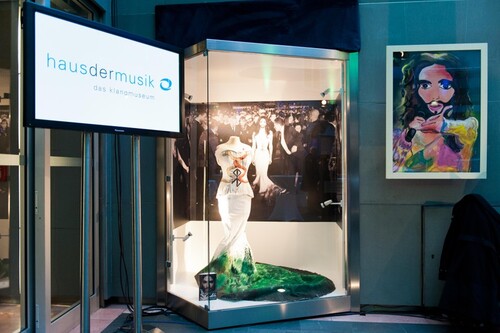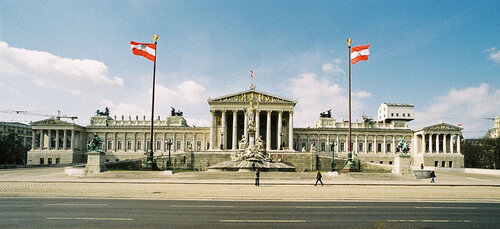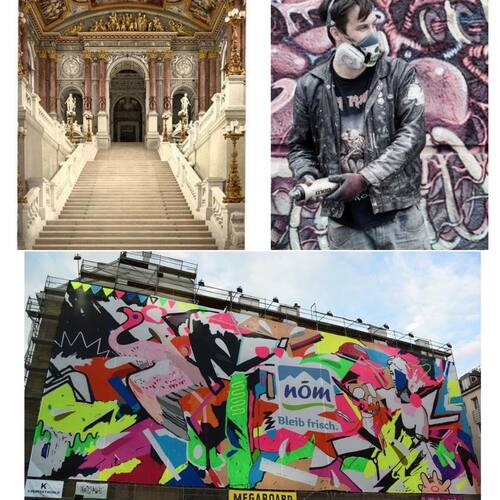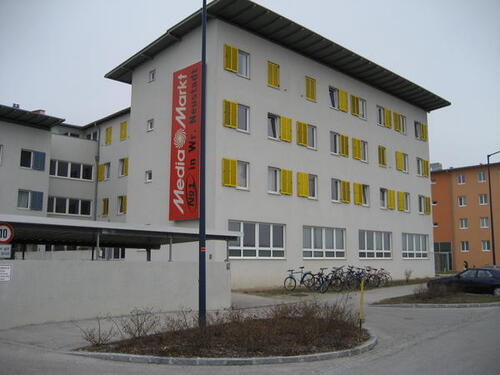-
Par Clara Kerneis le 7 Juin 2015 à 15:25
In Austria every season has its festivities : culture, music and traditions. This is an opportunity to immerse themselves in local life and meet warm and welcoming locals.
More than 400 balls take place in Vienna every winter, attracting some 300,000 fans from around the world. Between the Opera Ball and the Life Ball, there are dances for all tastes and at all prices.
The ball is a unique tradition that dates back to the eighteenth century. Wearing masks and costumes was then reserved for the aristocracy and the private sphere. It's Emperor Joseph II who opened the spectators dance sessions rooms Hofburg, the imperial palace. Even today, we find in all these balls court etiquette: a majestic place, a strict dress code, the opening fanfare, the entry of beginning teachers, the sequence of different dances and musical genres . Another unique tradition, Damenspende, a small gift of choice given to each visitor upon entering the ballroom.
The origin of the famous waltz from Vienna goes back to the popular dances of Southern Germany the sixteenth and seventeenth centuries. The waltz word comes from the German walze meaning "turn". Originally a peasant dance, she will seduce Vienna and the Imperial Court. Couple dance by excellence, inspires the greatest composers like Beethoven, Brahms, Chopin, Ravel...
The Austrians pay close attention to the year-end holidays. There are hundreds of Christmas markets in this period. They settled Advent, on the big squares of Austrian cities. One finds there gastronomic specialties but also small handicrafts. The best known are those of Vienna or Graz and Slazbourg.
In Vienna, the Rathausplatz found 150 stalls offering Christmas gifts, decorations for trees, sweets and hot drinks.
Further on is the village Christmas in the square Maria-Theresien between the Natural History Museum and the Museum of Fine Arts. More than 70 stands offer traditional crafts and original gift ideas. You can also see the cultural and Christmas market in front of the Schönbrunn Palace, it turns into a New Year market after Christmas. The market brimming with animated features traditional crafts, Christmas decorations handmade, Christmas concerts and an extensive program for children.
For children, the Christmas market on Karlsplatz is ideal. Besides a varied program for children, arts and crafts is mostly offered here. On the place of the Big Wheel, activities for children are organized as musical live acts and a fun show program.
Carnival is also a very popular event in Austria which takes place from Epiphany to Ash Wednesday. The tradition of disguise comes from the time when one could once a year to remove the differences in social standing behind a mask and costume.
Between January and February, there is many parades such as ski races in costume. On the Sunday before Mardi Gras, the "Faschingssonntag", there are many costume parties throughout the country, as in Ebensee (Upper Austria), known for its Carnival rags. In the Tyrol, several villages (Nassereith, Imst, Telfs, Axams and Thaur) in turn organize parades with period costumes and carved masks.
Lederhosen were worn by Austrian boys from the 1930s to the 1970s and were once widespread among men of the Alpine and surrounding regions, including Bavaria, Austria, the Allgäu and the Italian region of Trentino-Alto Adige/Südtirol. Today, they are worn on special occasions, such as a Biergarten or Zeltfest. Girls wear the Dirndl, which is part of Austrian Tracht.
Lederhosen were originally not exclusively a Bavarian garment but were worn all over Europe, especially by riders, hunters, and other people involved in outdoor activities. The flap, drop front, may have been a unique Bavarian invention. The drop-front style became so popular in the 18th century that it was known in France as à la bavaroise, "in the Bavarian style."
The popularity of lederhosen in Bavaria dropped sharply in the 19th century. They began to be considered as uncultured peasants' clothing that was not fitting for modern city-dwellers. Lederhosen have remained regionally popular and are popularly associated with virility and brawn. Some men wear them when gardening, hiking, working outdoors, or attending folk festivals or beer gardens.
They are a symbol of regional pride in Bavaria and the other areas where they are worn, but are rarely seen elsewhere. The role of lederhosen in Bavaria is thus comparable to that of the kilt in Scotland and the cowboy hat in the United States.
 votre commentaire
votre commentaire
-
Par Clara Kerneis le 7 Juin 2015 à 14:16
A great musical event was held in Vienna from 18 to 23 May : Eurovision Song Contest.
The Eurovision Song Contest is one of the longest running television shows in the world. It was on the 24th of May, 1956, that Europe saw the first ever Eurovision Song Contest. After all those years, the contest is one of the most typical European traditions and without doubt, Europe's favorite TV show.
It took place in Austria because Conchita Wurst won in 2014. The competition also celebrating its 60th anniversary, the theme was "Building Bridges". In addition, nearly 200 million people watched the show and the city of Vienna has received an influx of thousands of tourists for this occasion. Indeed, new shows at the Wiener Stadthalle was organized, a Eurovision village was built on the place of the Town Hall. We have seen in the streets hundreds of flags to the effigy of all the participating countries. Of course we support the France represented by Lisa Angeli.
Finally, the winner is Swedish Mans Zelmerlöwchanteur with his song Heroes. He is a young musician, model, presenter and Swedish dancer, known to the public since 2005 in Sweden after participating in Idol.
On the occasion of Eurovision, the city of Vienna has organized several exhibitions that show behind the scenes of the musical competition.
First for 60 years of the Eurovision Song Contest, Vienna's Museum organizes an exhibition is held in the courtyard of the museum. It includes audio and video recordings of Austrian artists of the past 60 years and a Jukebox that allows visitors to select their favorites.
Another temporary exhibition takes place at the Leopold Museum led by the winner of the Bachmann Prize and cartoonist Tex Rubinowitz. It is a declared fan of the Eurovision Contest and is interested in the so-called "zero points", these are the 34 participants who have collected any points in the last 60 years. It shows the faces of these ultimate losers on old wooden tables.
 votre commentaire
votre commentaire
-
Par Clara Kerneis le 4 Juin 2015 à 20:13
Regarding the news in Austria, I find that we speak little of that in France. So I went to see the news of the country on LeMonde.fr. I spotted an article dated February dealing with the modernization of the law on Islam in Austria.
Austria is an open and tolerant country and the first to give official status to the Muslim religion in 1912. The Austrian Parliament adopted Wednesday, 25 February new legislation to promote "an Islam of a European nature," to avoid the radical drift. It prohibits the financing of cult organizations and imams by foreign funds and imams must master German.
This new law aims also to promote "Islam of a European nature," according to Sebastian Kurz, the Conservative foreign minister and integration. This text for the first time, incorporates the right for Muslims to have chaplains in the army, hospitals, retirement homes and prisons, as well as the right to halal food, including at public school. It also requires compliance by residents of the celebration of Muslim holidays when they give rise to gatherings around places of worship. Or, it establishes Islamic theology courses at the university.
This initiative is closely followed by several European countries, including France, where the Prime Minister, Manuel Valls, has announced plans to also prevent the financing of imams by foreign funds. This law has been preparing for two years and is not directly related to recent Islamist attacks in Europe. However, Austria is a country with nearly 200 nationals who have left the country to join the ranks of jihadists in Syria and Iraq.
Unfortunately, the strongest criticism comes from Turkey where originates a significant proportion of Muslims in Austria. Many imams in Austria are paid by the Turkish state (about 60%), it is the scenario of a detour by foundations to avoid breaking the law. They perceive the law as "discriminatory" and "stigmatizing". The main Muslim federation IGGiÖ, which is endowed with an institutional role, approved the text with reservations. Several other organizations have seen in these measures, intended to strengthen the state control and limit foreign influence, "discrimination", the restriction on foreign funding targeting a single religious community in Austria.
However, other countries have applied the law as in Germany where adoption has been widely welcomed.
 votre commentaire
votre commentaire
-
Par Clara Kerneis le 12 Mai 2015 à 00:25
For my free article, I have chosen an interesting subject which I have really appreciated in Vienna : Street art.
Graffitis are very famous in Austria and particularly in Vienna. Over 100 years ago, Gustav Klimt and the Vienna Secessionists fought for freedom of self-expression. Vienna has a long history of attracting groundbreaking artists and controversial bohemians. While the conservative Viennese can initially act reluctant to embrace new things, they are likewise rather good at not taking their ambivalence too seriously. The Austrian government supported the talented and rebellious Klimt with a public area for their work.
Perhaps for this reason it’s not so surprising that the Austrian government has made a similar gesture to the young, controversial, revolutionary artists of our generation ; the graffiti artists, by granting them Vienna’s blessing to spray certain public areas.
So let’s grab an ice-cream at Schwedenplatz, take a nice cool stroll along the canal and admire the artwork of this generation’s radical philosopher artists.
Basically, most people think of Vienna : opera houses and dead classical composers. That’s what I expected before to come here during five months. And that's true that Vienna has a big reputation for being a “pretty” European capital. I found Vienna’s reputation for beautiful architecture, wide avenues, lots of atypical shops and safe ambiance. But, I have discover an pretty cool city, too. In between the classically styled buildings and sidewalk cafes is some fairly interesting street art.
The street art in Vienna is actually less graffiti and more… art and pretty. By the way, they call their graffiti by what it actually is : street art.
Everything in Vienna appeared to be designed and the reputation for art and design is fairly renowned. There is a paradox in Vienna, firstly we found an nice architecture, classical and grandiose. And then hidden along the Danube or in an little street are street art style and graffiti designs. Everything in this city were being stylish or interesting, from the trash bins to the water fountains.
But one other thing stood out on the streets of Vienna : the posters ! Because it’s often a good way to see what the local trends in design are and sometimes the only way to find out about events or concerts. We can say that Vienna is the art city, that's why I was not surprised to see many art and gallery exhibits advertised around the city.
 votre commentaire
votre commentaire
-
Par Clara Kerneis le 16 Mars 2015 à 21:13
The University of Applied Sciences Wiener Neustadt is founded in 1994. The main campus is in Wiener Neustadt and two smaller campuses are located in Wieselburg and Tulln. The business school offers a course called Business Consultancy International, a bachelor degree program, which is exclusively taught in English. Another program taught in English is the Aerospace Engineering Master program.
We were very well received by international responsibilities, teachers and students. There are many different cultures in each class, Finnish, Korean, Mexican, Russian, French, German meet every day. We live in the same residence, thus we share a lot of things together.
This Saturday, March 14 took place the open house of the school. The exchange student were cooking specialties from their country. We prepared some dishes : quiche, pain perdu, camembert toasts, crêpes, oliv cake and ham cake.
From my point of view, FH system is similar to that of ESDES. Concerning courses, we see many concept already seen in class in France. However, they courses are quite longer, from 1h30 for microeconomics, to 3h30 for marketing with 20 mins break. It is quite difficult with the language because we are not used to having courses in English in France. Also, teachers can be stricts and others more lax but we can always leave the room when we want. In France, if we leave the room we ask permission to the professor to avoid disturbing the class. Here, no one asks if anyone wants out, he does. Concerning absence, I think it is similar with ESDES. We may be missing to 2 times maximum for each course, otherwise we can not pass the final exam. In addition, we are not all the time with exchangers because we have class with regular students, it is interesting to know other people who live here all the year.
I realized that it was very nice to leave with other foreign people because we learn many things about their culture and their country like specific cuisine, traditional event or the language. But we learn also about us. We participate in a course called Intercultural Business Skills, with others exchangers and where we learn how foreigners see us though our own culture. For example, for them, French is seen as a man with a mustache, baguette in one hand and smelly. But we are also the best for cosmetic, perfume, high fashion and we have delicious cuisine.
In addition, during five month, we live in a nice dorms near the university. There are three buildings, we live in building with third floors and the exchangers live on the first floor. Regular students live in the others. We are two by apartment with private room, kitchen, and bathroom. Each floor have one common kitchen when we want to joins us all together.
Restaurants, cinema, bar, shop, swimming pool, bowling are 10 minutes walk to the dorms, the city center of Wiener Neustatd is 15 minutes by bus and Vienna, 30 minutes by train. With our student card, we do not pay the bus and we have a reduction to take the train.
 votre commentaire
votre commentaire Suivre le flux RSS des articles de cette rubrique
Suivre le flux RSS des articles de cette rubrique Suivre le flux RSS des commentaires de cette rubrique
Suivre le flux RSS des commentaires de cette rubrique













